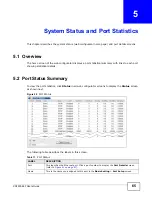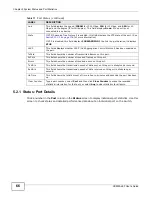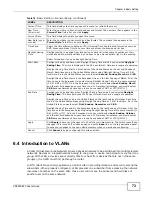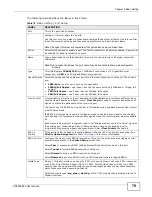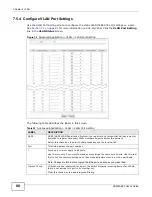
Chapter 6 Basic Setting
XS3900-48F User’s Guide
75
GARP Timer: Switches join VLANs by making a declaration. A declaration is made by issuing a Join message
using GARP. Declarations are withdrawn by issuing a Leave message. A Leave All message terminates all
registrations. GARP timers set declaration timeout values. See
for more background
information.
Join Timer
Join Timer sets the duration of the Join Period timer for GVRP in milliseconds. Each port has
a Join Period timer. The allowed Join Time range is between 100 and 65535 milliseconds;
the default is 200 milliseconds. See
for more background
information.
Leave Timer
Leave Time sets the duration of the Leave Period timer for GVRP in milliseconds. Each port
has a single Leave Period timer. Leave Time must be two times larger than Join Timer;
the default is 600 milliseconds.
Leave All Timer
Leave All Timer sets the duration of the Leave All Period timer for GVRP in milliseconds.
Each port has a single Leave All Period timer. Leave All Timer must be larger than Leave
Timer.
Priority Queue Assignment
IEEE 802.1p defines up to eight separate traffic types by inserting a tag into a MAC-layer frame that contains
bits to define class of service. Frames without an explicit priority tag are given the default priority of the
ingress port. Use the following fields to configure the priority level-to-physical queue mapping.
The Switch has eight physical queues that you can map to the 8 priority levels. On the Switch, traffic assigned
to higher index queues gets through faster while traffic in lower index queues is dropped if the network is
congested.
Priority Level (The following descriptions are based on the traffic types defined in the IEEE 802.1d standard
(which incorporates the 802.1p).
Level 7
Typically used for network control traffic such as router configuration messages.
Level 6
Typically used for voice traffic that is especially sensitive to jitter (jitter is the variations in
delay).
Level 5
Typically used for video that consumes high bandwidth and is sensitive to jitter.
Level 4
Typically used for controlled load, latency-sensitive traffic such as SNA (Systems Network
Architecture) transactions.
Level 3
Typically used for “excellent effort” or better than best effort and would include important
business traffic that can tolerate some delay.
Level 2
This is for “spare bandwidth”.
Level 1
This is typically used for non-critical “background” traffic such as bulk transfers that are
allowed but that should not affect other applications and users.
Level 0
Typically used for best-effort traffic.
Apply
Click Apply to save your changes to the Switch’s run-time memory. The Switch loses these
changes if it is turned off or loses power, so use the Save link on the top navigation panel
to save your changes to the non-volatile memory when you are done configuring.
Cancel
Click Cancel to begin configuring this screen afresh.
Table 15
Basic Setting > Switch Setup (continued)
LABEL
DESCRIPTION
Summary of Contents for XS-3900-48F
Page 15: ...15 PART I User s Guide ...
Page 16: ...16 ...
Page 48: ...Chapter 2 Tutorials XS3900 48F User s Guide 48 ...
Page 62: ...Chapter 4 The Web Configurator XS3900 48F User s Guide 62 ...
Page 63: ...63 PART II Technical Reference ...
Page 64: ...64 ...
Page 227: ...Chapter 26 VLAN Mapping XS3900 48F User s Guide 227 ...
Page 320: ...Appendix A Common Services XS3900 48F User s Guide 320 ...
Page 332: ...Index XS3900 48F User s Guide 332 ...





